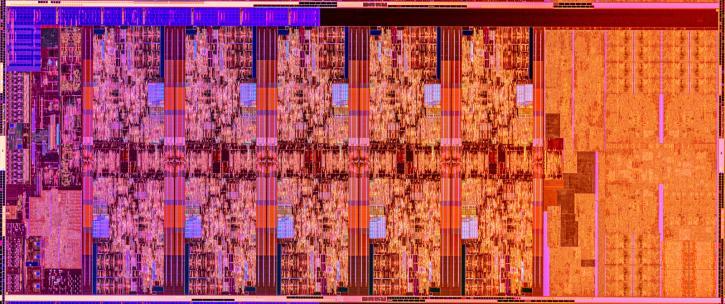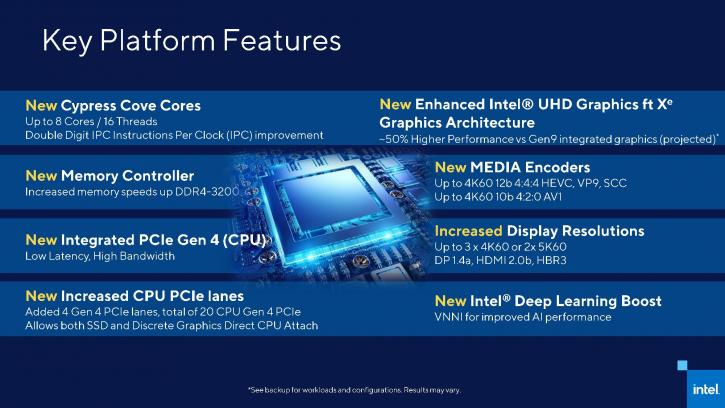Comet Lake processors
10th Generation Core series processors (CML)
Intel has been expanding its line-up, with processors up to 10 cores (and thus 20 threads) now available in the desktop segment (not HEDT). They market this series as the Core range, whereas HEDT is Core-X. More recently Intel has been adding the denominator “Core i9” to that desktop lineup. The processors are paired with the 400 (and now the 500) series chipset, which introduced a new processor socket, LGA1200. The review sample for this review is the Core i9-10850K, (almost) the top-of-the-line processor (besides the 10900K which has 100 MHz more frequency) in the desktop range of products, with 10 cores and 20 processing threads. It has 20 MB of L3 cache, 16 PCI-Express 3.0 lines on the CPU, DDR4 @ 2933 MHz Dual-Channel memory configuration support, and 125W TDP.
Velocity Boost
Intel has a classification for its highest boosting frequency, called 'Thermal Velocity Boost'. It’s an extra boost of 100 MHz on both the single and all-core turbo, however, it is only activated under certain conditions. These conditions, as you can tell by the name, involve the temperature of the processor, which needs to remain below 70 degrees Celsius. Once the processor gets warmer than this value it decreases clock frequency. Single-core boost is limited to 5.1 GHz or even 5.0 GHz without Turbo Boost Max 3.0. This technology was introduced with Cascade Lake-X and is now available in mainstream desktop PCs to ensure that single-threaded tasks run on the fastest cores. Pretty much end-users with liquid cooling will benefit from this the most.
Architecture changes
The Comet lake series processors have genuinely been based on the Skylake architecture as a building block, which you know from pretty much all socket 1151 parts, but were then scaled upwards, and from there on we have seen some tweaks and fabrication process updates. So that means Intel is still at its 14nm node. Opposed to expensive architecture changes in the cache and so on, Intel has been using the architecture as a modular design, adding cores. Intel applies a familiar L2 cache of 256 kB and L1 is at 64kB in total (32kB data + 32kB instruction caches). However, relative to that, the L3 cache is 2 MB per core. With these processors, you will now see three Turbo modes dubbed 2.0, 3.0, and Velocity boost, which I explained in more detail in the paragraph above. Comet Lake-S processors offer an increase in clock frequencies and thus performance, as well as addressing security fixes in hardware, for better protection against side-channel attacks. This series offers 40 PCIe Gen 3.0 lanes in total (16 from the CPU and 24 available from the chipset, with 4 used as a DMI 3.0 interlink between the CPU and chipset). You'll notice Wi-Fi 6 and 2.5GbE support for these new processors, but don't get confused, as that is not native. The controllers are simply made compatible, so motherboard manufacturers can opt to add in the appropriate modules as a feature.
Comet Lake Die, count and spot them, that's 10 cores.
TDP - PL States
Comet Lake processors are allowed to run load values considerably higher and longer than 9th gen Coffee Lake. The TDP that is specified/listed is now 125 Watts. However, the story does not end there, as that is the P1 state. For a 9900K, that value sits at 95W. With the Comet Lake S, it’s 125W. Of course, it is two more cores, so nobody will wonder about that. However, there is also a PL2 state, with a higher power limit that can be applied for a relatively short time. Let's take the 9900K again. It had a PL2 allowance of 1.25 times PL1, = 119W, for a duration of 28 seconds. If I take the 10900K as an example, PL2 now is 2 times PL1, so 250W. That PL2 state is now also longer, at 56 seconds. And therein lies the benefit of additional performance.
|
CPU |
P1 State |
PL2 State |
Duration |
|
Core i9 10900K |
125 Watt |
250 Watt |
56 seconds |
|
Core i7 10700K |
125 Watt |
229 Watt |
56 seconds |
|
Core i5 10500K |
125 Watt |
182 Watt |
56 seconds |
|
Core i9 9900K |
95 Watt |
118 Watt |
28 seconds |
|
Core i9-9900KS |
127 Watt |
159 Watt |
28 seconds |
In short, this means the overall performance of Comet Lake could be a lot higher compared to Coffee lake and older processors, but that also will have an effect on power consumption and inevitably, heat levels. That new PL2 state duration of nearly a minute, however, is significant. With such high power states, we do fail to see the point and reliability of a listed TDP value these days if you allow double the TDP for almost a minute.
The Z590 chipset
| Z590 | Z490 | Z390 | |
|---|---|---|---|
| OC / Tweaking | Yes | Yes | Yes |
| PCIe lanes CPU | 20 / Gen 4 | 16 | 16 |
| PCIe lanes chipset | 24 / Gen 3 | 24 | 24 |
| SLI / Crossfire | Yes | Yes | Yes |
| SATA3 | 6 | 6 | 6 |
| USB 3.2 2x2 | 6 | - | - |
| USB 3.1 | - | 6 | 6 |
| USB 3.0 | 10 | 10 | 10 |
| USB 2.0 | 14 | 14 | 14 |
| AX WiFi 6 | Yes, by CNVi | Yes, by CNVi | - |
| 2.5 Gigabit LAN | Yes, by PHY | Yes, by PHY | - |
While the new Z590 motherboards can handle PCI Express 4.0, that’s possible only with the Rocket Lake-S processors. The CPU-to-chipset link has been doubled from DMI x4 to DMI x8 (with Rocket Lake-S). This means an effective CPU-to-chipset bandwidth of a PCIe 3.0 x8 link and suggests that two PCIe 3.0 x4 drives can be attached and run at full speed. The x8 link only works with Rocket Lake CPUs and will downgrade to x4 with a previous generation processor. The Z590 platform enables the processor to use PCIe 4.0. Intel will include native CPU PCIe 4.0 support for the first time, 20 lanes of it, which will enable a full x16 link for add-in cards as well as another PCIe 4.0 x4 for storage. Vendors will be able to split that x16 as required, similar to previous mainstream motherboards, into an x8/x8 or x8/x4/x4 bifurcated solution, with appropriate muxing. The third update is native USB 3.2 G2x2 (20 Gbps) Type-C support from the chipset. Motherboards that take advantage of this feature will likely enable it either on a front panel or rear panel connector, although it is optional.



